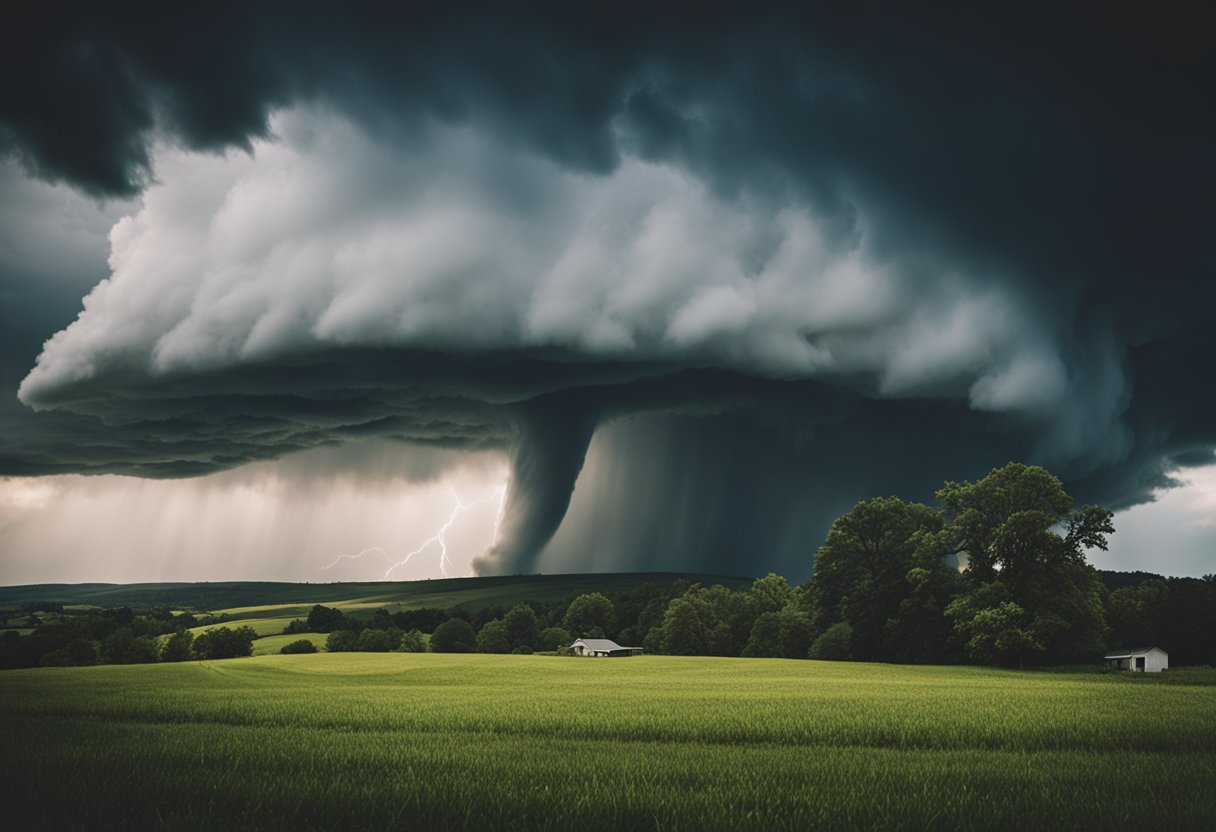Tornadoes are one of the most violent and unpredictable natural disasters. In Tennessee, their occurrence can lead to significant devastation due to the state’s location within the southeastern United States, an area prone to such meteorological events. Understanding the science behind tornadoes is crucial for assessing risks and preparing for potential impacts.


The paths of tornadoes and their impact on Tennessee vary, with some regions being more susceptible than others. Emergency response and public safety measures must be agile and responsive to adequately protect residents and infrastructure. The aftermath of tornadoes often results in a concerted effort towards recovery and reconstruction, highlighting the resilience of affected communities.
Key Takeaways
- Tornadoes pose a significant risk in Tennessee, necessitating a deep understanding of their nature for effective preparedness.
- Infrastructure damage and community impacts highlight the importance of emergency response and public safety measures.
- Recovery and rebuilding efforts are crucial to restoring normalcy in the wake of tornado-related destruction.
Science of Tornadoes
Tornadoes are a violent meteorological phenomenon, and understanding their science is key to forecasting and safety measures.
Formation
A tornado forms when warm, moist air collides with cold, dry air, creating instability in the atmosphere. This can lead to the development of a supercell, a type of thunderstorm with a deep, persistent rotating updraft called a mesocyclone. When atmospheric conditions are favorable, the rotating air can tighten and intensify, forming a tornado’s characteristic funnel cloud.
The National Weather Service (NWS) plays a pivotal role in identifying these conditions and issuing tornado warnings to alert the public of severe weather. They utilize a variety of tools including Doppler radar, satellite, and storm spotter reports to monitor storm development.
Classification
Tornadoes are classified based on the Enhanced Fujita Scale (EF Scale), which ranges from EF0 to EF5:
- EF0: Winds 65-85 mph (Minor or light damage)
- EF1: Winds 86-110 mph (Moderate damage)
- EF2: Winds 111-135 mph (Considerable damage)
- EF3: Winds 136-165 mph (Severe damage)
- EF4: Winds 166-200 mph (Devastating damage)
- EF5: Winds >200 mph (Incredible damage)
The classification is determined by assessing the damage caused by the tornado, with higher numbers indicating more destructive potential. It is a tool used by the NWS for reporting and researching severe weather events.
Tornado Paths And Impact On Tennessee
Tornadoes significantly affect Tennessee’s landscape and communities, especially in regions like Middle Tennessee. Their paths have led to remarkable changes and challenges over the years.
Historical Tornadoes
Tennessee has a history of destructive tornadoes with paths that have cut through various parts of the state, leading to loss of life and property. One of the most prominent examples is the Super Tuesday Tornado Outbreak in February 2008. During this event, 22 tornadoes touched down across the state, including an EF4 that struck the Union University in Madison County, resulting in severe damage. In terms of path, these tornadoes often follow the Tennessee River Valley, exhibiting patterns that weather professionals analyze to predict future tornado behavior and potential impact areas.
| Date | Location | Magnitude |
|---|---|---|
| Feb 5, 2008 | Madison County | EF4 |
| Apr 27, 2011 | Hamilton County | EF5 |
| Mar 3, 2020 | Middle Tennessee | EF4 |
Historical tornado paths through the state have led to improved warning systems and building codes designed to mitigate the impact of these powerful storms on Tennessee’s residents and infrastructure.
Middle Tennessee
Middle Tennessee, including Nashville and Clarksville, is particularly vulnerable to tornadoes due to its geographic location. The region lies in the path of the southeastward transition zone where cold, dry air from the north converges with warm, moist air from the Gulf of Mexico, setting the stage for severe thunderstorms and tornadoes. For example, on March 3, 2020, a series of tornadoes struck Middle Tennessee, where an EF4 tornado followed a 60.13-mile path through Nashville to Putnam County, causing widespread destruction. Another notable tornado in recent history occurred on January 22, 1999, severely impacting Montgomery County with a path that took it directly through Clarksville, resulting in significant damage to both residential and commercial properties.
| Location | Tornado Date | Path Length | Damage | Casualties |
|---|---|---|---|---|
| Nashville | Mar 3, 2020 | 60 miles | Extensive to homes & businesses | 25 |
| Clarksville | Jan 22, 1999 | 4 miles | Major damage to buildings | 0 |
These events have reinforced the importance of emergency preparedness and awareness for the residents of Middle Tennessee.
Emergency Response And Public Safety
In the wake of a tornado in Tennessee, emergency services are promptly mobilized to ensure public safety, while various shelters and relief centers are established for affected residents.
Emergency Services
The Tennessee Emergency Management Agency (TEMA) takes a leading role in coordinating the immediate response efforts after a tornado strikes. They work in conjunction with local authorities to assess the damage, conduct search and rescue operations, and provide necessary aid. Clarksville Mayor Joe Pitts often communicates directly with residents to keep them informed on safety measures and the assistance available. In severe cases, a State of Emergency may be declared to facilitate a more efficient response and unlock additional resources.
-
Key Functions:
- Damage assessment
- Search and rescue
- Aid distribution
-
Response Tools and Methods:
- Mobile command centers
- Emergency alert systems
- Public safety broadcasts
Shelters And Relief
In response to displaced individuals and families, emergency shelters are typically set up in accessible locations, such as schools and community centers. The purpose of these Emergency Shelters is to provide temporary housing, food, medical care, and psychological support. Each shelter’s capacity and services are regularly communicated through official channels to ensure the public is well-informed about where they can find refuge and support.
-
Services Provided at Shelters:
- Accommodation
- Meals
- Health services
- Counseling
-
Shelter Locations Include:
- Local schools
- Community centers
Effects Of Tornadoes On Communities
Tornadoes bring significant disruption to communities through destruction of infrastructure and economic destabilization. These events reconfigure the landscape and challenge the resilience of the affected areas.
Infrastructure Damage
When tornadoes hit, power lines often sustain considerable damage, resulting in widespread power outages. The force of such storms can easily topple utility poles and scatter debris, causing not just transient inconveniences but also hazardous conditions for residents and first responders. Houses and buildings bear the brunt of the impact with roofs, walls, and sometimes entire structures being ripped apart. Communities face a long road to recovery as they must clear debris and rebuild their physical environment to regain normalcy.
Economic Losses
The economic toll on a community after a tornado is multifaceted. Direct costs arise from the need to repair or rebuild damaged infrastructure and homes. Indirect costs are tied to the ripple effects of business interruptions, which can result in job losses and a decrease in tax revenue for the community. In Tennessee, the agricultural sector can be particularly vulnerable, with tornadoes capable of wiping out entire crop fields or livestock, thereby compounding the financial strain on the local economy. The process of reclaiming and bolstering the local markets demands substantial investment and time.
Recovery And Reconstruction
The tornado’s aftermath has triggered a systematic response geared towards recovery and the rebuilding of affected areas with a focus on immediate post-disaster management and fostering long-term community resilience.
Post-Disaster Management
After the tornado struck, authorities in Clarksville and Hendersonville swiftly launched recovery efforts. They prioritized debris removal and infrastructure repair to facilitate the return of displaced residents. Fort Campbell quickly became a hub for these operations, with military and civilian teams working diligently to restore normalcy.
-
Debris Removal: Essential for safe access and reconstruction.
- Clarksville: Coordinated efforts with local organizations.
- Hendersonville: Community volunteers and city services mobilized.
-
Infrastructure Repair: Restoring utilities and services.
- Electricity and water supplies: Reestablished within days.
- Roadways and bridges: Temporary solutions implemented to ensure connectivity.
Community Resilience
Neighbors played a pivotal role in the recovery, embodying the spirit of community resilience. Through coordinated volunteer actions and the establishment of support systems, these communities demonstrated their ability to adapt and rebuild.
-
Volunteer Efforts:
- Clarksville and Hendersonville: Neighbors organized supply distribution.
- Fort Campbell: Provided manpower and logistical support.
-
Support Systems:
- Emotional: Counseling services for impacted families.
- Financial: Fundraisers and grants to aid reconstruction.
Frequently Asked Questions
In this section, we address common inquiries regarding tornado preparedness, vulnerability, warning systems, post-event actions, frequency, and recovery resources specific to Tennessee.
How can residents prepare for a tornado in Tennessee?
Residents in Tennessee can prepare for tornadoes by creating an emergency plan, assembling a disaster kit, and staying informed about local weather conditions. It’s crucial for families to practice drills and ensure they know the safest place to shelter in their home or community.
What areas of Tennessee are most vulnerable to tornado damage?
The central and western regions of Tennessee, including the Middle Tennessee area and the cities along the Mississippi River, are typically more prone to tornadoes due to the geographical and atmospheric conditions that favor their formation.
Are there any early warning systems in place for TN tornadoes?
Tennessee has a system of sirens and an extensive network of weather radio broadcasts to alert residents of tornado activity. The National Weather Service also provides real-time updates and warnings through multiple platforms.
What steps should be taken after a tornado has occurred in Tennessee?
After a tornado, residents should first ensure personal safety and then check on neighbors. They should report hazards such as gas leaks or downed power lines to authorities and document property damage for insurance claims.
How does tornado frequency in Tennessee compare to other states?
Tennessee has a relatively high frequency of tornadoes when compared to many other states, although it experiences fewer tornadoes annually than “Tornado Alley” states in the central United States.
What resources are available for tornado recovery and assistance in Tennessee?
Recovery resources in Tennessee include federal aid from FEMA, local disaster relief services, and non-governmental organizations like the American Red Cross. These resources provide financial support, essential supplies, and assistance with rebuilding efforts.
